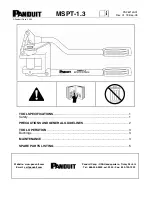
components that require a high volume of data interchange such as the
flight data recorder.
In addition to the I/O modules, the MAUs contain:
•
Aircraft Personality Modules (APMs) - two (2) housed within Timing
Network Interface Controllers (TNICs) in MAUs #1 and #2 that retain
aircraft configuration data such as installation serial numbers, identifiers,
and
configuration
options
(SELCAL addresses,
MagnaStar
phone
numbers, etc.). Two (2) additional APMs are incorporated in the Modular
Radio Cabinets to store communication management functions.
•
Data Base Modules (DBMs) - provide non-volatile memory for navigation
and terrain data bases and store aircraft maintenance data. The DBMs are
accessed through the cockpit data management unit (DMU) or through the
remote Personal Computer (PC) Local Area Network (LAN) data ports
located on the test and monitor panel.
•
Central Maintenance Computer (CMC) module - monitors the condition
and health of all aircraft components interfaced with the MAUs, storing
detected faults, constructing a fault history database and providing a
diagnostic guide for system troubleshooting. The CMC module is equipped
with a D-sub connector, enabling use of a PC for fault downloading and
system checks.
•
Advanced Graphics Modules (AGMs) - generate the visual information
shown on cockpit display units including Primary Flight Displays (PFDs),
Navigation displays, Crew Alerting System (CAS) messages, Synoptic and
System Window displays, uploaded weather overlays and real-time video
from aircraft cameras
•
EGPWS module - provides all of the functionality of the Enhanced Ground
Proximity Warning System and stores the terrain database
•
Global Positioning System (GPS) modules - interpret data received by the
GPS antenna to compute aircraft position. Position information is
communicated to using elements within the MAUs over a dedicated
ARINC-429 bus rather than through the MAU backplane. The GPS
modules have separate direct bus paths to the Inertial Reference System
(IRS) to provide full initial and continuous alignment data.
•
Video Module - provides initial formatting of aircraft camera analog video
for subsequent use by the AGMs in constructing the Cameras system
display window.
The high degree of integration of all modules and functions residing in the MAUs
and MRCs offers the flight crew instantaneous comprehensive oversight for all on
board aircraft systems.
2. Indicating and Recording Subsystems:
Although all indicating and recording functions are distributed throughout the
PlaneView system, The specific functions of the indicating / recording system are
divided into the following subsystems:
•
2A-31-20: Cockpit Clock System
•
2A-31-30: Digital Flight Data Recorder System
•
2A-31-40: Data Management Unit
•
2A-31-50: Cockpit Printer
OPERATING MANUAL
PRODUCTION AIRCRAFT SYSTEMS
2A-31-00
Page 2
July 15/04
Title Page
Prev Page
Next Page
TOC



































